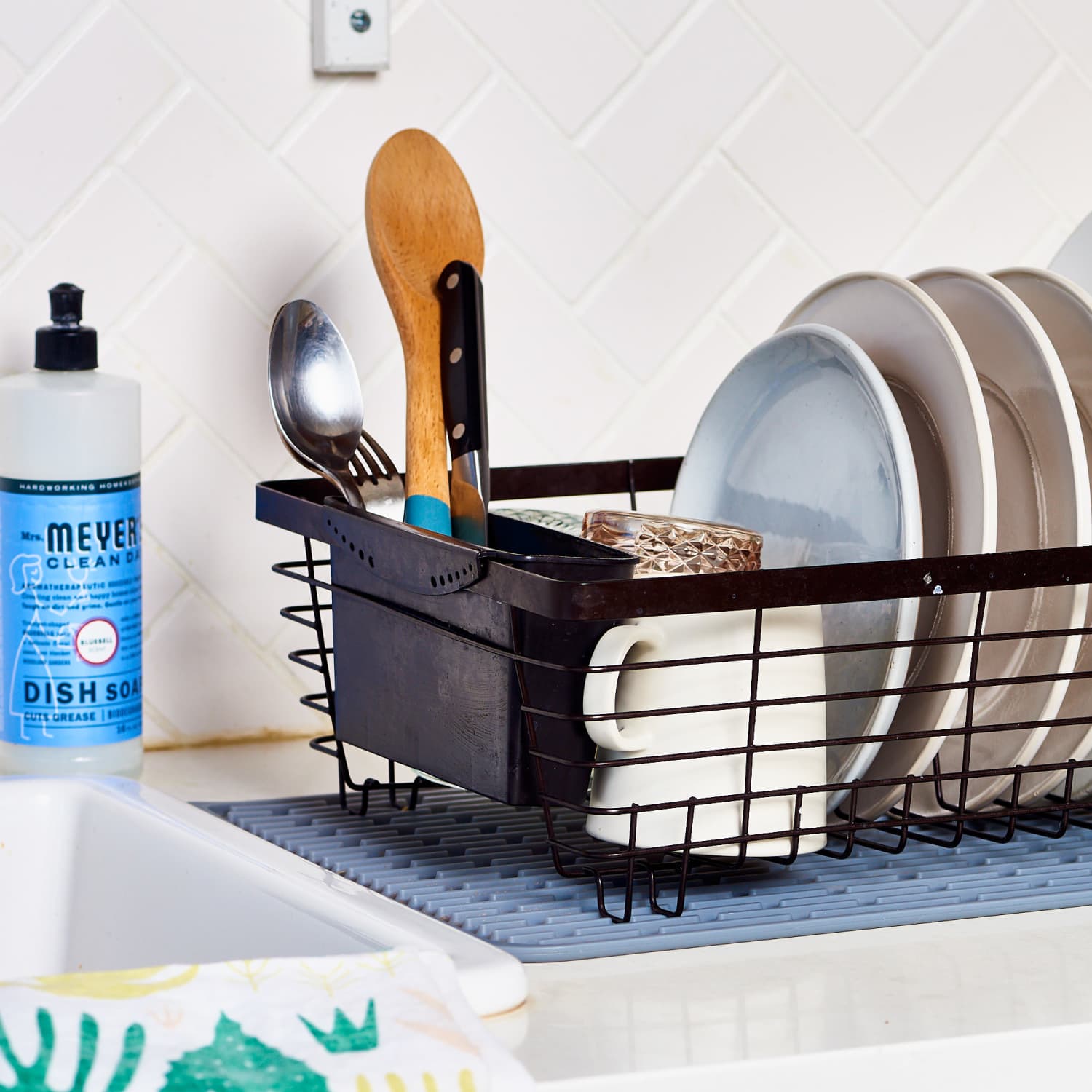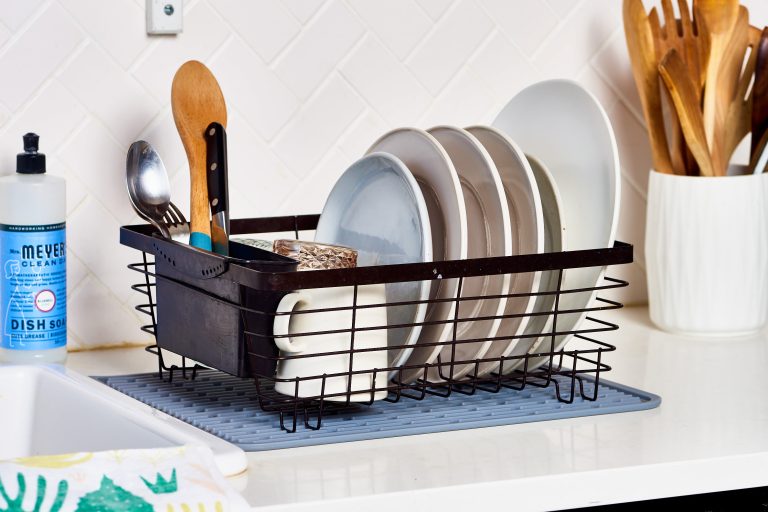You’ve washed your dishes, but there’s one lurking threat that might be hiding in your dish drying rack—mold. It’s sneaky, it’s stubborn, and it’s definitely not something you want near your clean plates and utensils.
Mold can not only ruin the look of your kitchen but also pose health risks. You might not even realize it’s there until it’s too late. But what if you could prevent this nasty invader from ever taking hold? Imagine your kitchen free from mold, where your dish rack stays fresh and clean, offering you peace of mind every time you tidy up.
You’ll discover simple yet effective strategies to keep mold at bay, ensuring your dish drying rack remains spotless and safe. Let’s dive into how you can protect your kitchen from this hidden enemy.
Causes Of Mold In Dish Drying Racks
Mold in dish drying racks can be a common household issue. Understanding what causes mold can help prevent it. A few factors contribute significantly to mold growth. Moisture buildup, poor air circulation, and material susceptibility play key roles. Addressing these can keep your dish drying rack mold-free.
Moisture Buildup
Water collects in dish drying racks after washing dishes. This moisture can linger, creating a perfect environment for mold. Regularly drying your rack helps reduce moisture. Ensure all dishes are thoroughly dried before placing them in the rack.
Poor Air Circulation
Airflow is essential to keep mold away. Dish drying racks often sit in corners or tight spaces. Limited air circulation can trap moisture. Place your rack in an open area. Allow air to move freely around it.
Material Susceptibility
Some materials are more prone to mold. Plastic and wood can absorb moisture easily. Choose racks made from stainless steel or other mold-resistant materials. This choice can make a big difference in mold prevention.

Credit: www.apartmenttherapy.com
Choosing The Right Dish Drying Rack
Selecting a dish drying rack with proper ventilation prevents mold growth. Ensure the rack allows air circulation. Regular cleaning is key to keeping mold away.
Choosing the right dish drying rack can be your first step in preventing mold buildup. Imagine coming home after a long day, only to find your dish rack is a breeding ground for mold. It’s not only frustrating but also unhygienic. With the right choice, you can keep your kitchen clean and mold-free.Material Selection
When selecting a dish drying rack, consider the material. Stainless steel is a popular choice because it resists rust and mold. It’s durable and easy to clean. Plastic racks can be appealing due to their lightweight nature. However, they can trap moisture, making them a potential hotspot for mold. If you prefer plastic, choose one with antimicrobial properties. Bamboo racks are eco-friendly and aesthetically pleasing. Ensure they are well-ventilated to prevent moisture retention. Regularly oiling bamboo can also extend its lifespan and reduce mold risk.Design Features
Design is crucial in preventing mold. Look for racks with proper drainage systems. A sloped base or removable drip tray can help direct water away, keeping the rack dry. Consider racks with open, airy designs that promote airflow. This helps dishes dry faster and prevents moisture buildup. Avoid complex designs with tight crevices where water can hide. Some racks come with adjustable features. These allow you to customize the setup based on your kitchen space. Flexibility can help you clean the rack thoroughly, minimizing mold growth. Have you ever thought about how your dish rack design could affect your health? The right design not only enhances your kitchen’s functionality but also keeps it hygienic. Choosing the right dish drying rack isn’t just about aesthetics. It’s about making a practical choice that keeps your kitchen safe and clean. Make sure your choice reflects your needs and prevents mold effectively.Effective Cleaning Techniques
Prevent mold in dish drying racks by ensuring proper airflow and drying after each use. Regularly clean with vinegar or baking soda to eliminate moisture buildup.
Preventing mold in dish drying racks requires regular cleaning. This ensures a hygienic kitchen environment. Mold thrives in damp and neglected spots. Proper cleaning techniques can stop mold growth.Daily Maintenance
Daily maintenance is crucial for keeping mold away. After using the drying rack, wipe it dry. Use a clean cloth to absorb excess water. Make sure all parts are completely dry. Remove any food particles left behind. These can attract mold. Rinse the rack with warm water. This helps in removing soap residue. Keep your kitchen well-ventilated.Deep Cleaning Methods
Deep cleaning should be done weekly. Use a mixture of vinegar and water. This solution is effective against mold. Soak the rack in this mixture for 15 minutes. Scrub the rack with a soft brush. Pay attention to corners and joints. Rinse thoroughly with clean water. Let it air dry completely. You can also use baking soda. Mix it with water to form a paste. Apply it to moldy areas. Let it sit for 10 minutes. Scrub and rinse the rack. Dry it well before using again. “`Enhancing Airflow
Enhancing airflow around your dish drying rack can prevent mold. Mold thrives in damp, poorly ventilated spaces. Improving airflow helps dishes dry faster and reduces moisture. Here’s how you can do it effectively.
Strategic Placement
Place your dish rack in a well-ventilated area. Avoid corners where air circulation is limited. Keep it away from walls to allow air to move freely around it. Consider placing it near a window if possible. Natural light and fresh air help in drying dishes faster.
Ventilation Tips
Ensure your kitchen is well-ventilated. Use an exhaust fan to remove moisture from the air. Open windows regularly to let fresh air in. Keep cabinet doors open occasionally to allow air circulation. These steps help maintain a dry environment.
Using Mold Inhibitors
Mold can be an unwelcome guest in your kitchen, especially in your dish drying racks. The damp and humid environment provides a perfect breeding ground for mold. But you can tackle this problem head-on by using mold inhibitors. These handy solutions help keep mold at bay, ensuring your dish drying racks remain clean and fresh.
Natural Solutions
Natural mold inhibitors can be an effective and eco-friendly way to prevent mold growth. One popular choice is using vinegar. Mix equal parts of water and vinegar, and spray it on your dish drying rack. This simple solution can help reduce mold growth.
Another natural option is tea tree oil. Known for its antifungal properties, tea tree oil can be mixed with water and applied to your racks. A few drops go a long way in keeping mold away. It’s a method that I swear by, as it keeps my kitchen smelling fresh too!
Commercial Products
If you prefer ready-made solutions, there are numerous commercial mold inhibitors available. These products are designed specifically to combat mold and are easy to use. Look for sprays or wipes that contain mold-fighting chemicals.
Brands like Lysol and Clorox offer mold-prevention products that are widely trusted. Using them regularly can make a significant difference. However, always ensure the product is safe for kitchen use.
Have you ever wondered if your dish drying rack could stay mold-free effortlessly? These commercial solutions might just be what you need to achieve that.
By integrating these mold inhibitors into your routine, you can maintain a cleaner, healthier kitchen environment. Which method will you try first?

Credit: www.danielappliance.com
Regular Inspection And Maintenance
Regular inspection and maintenance of dish drying racks help prevent mold growth. Dry racks thoroughly after each use to stop moisture buildup. Clean racks weekly with mild soap and water to keep mold at bay.
Keeping your dish drying rack mold-free is easier than you might think. Regular inspection and maintenance play a crucial role in ensuring your rack remains clean and hygienic. By dedicating a small amount of time each week to check your rack, you can prevent mold from becoming a headache.Signs Of Mold
Mold often appears as black, green, or white spots. You might notice a musty smell coming from your drying rack. It’s not just unpleasant; mold can affect your health. Even if your rack looks clean, inspect it closely. Pay attention to corners and crevices where moisture can hide. Have you noticed a slimy texture on parts of your rack? That’s a clear indicator of mold growth.Routine Checks
Set a regular schedule for checking your dish drying rack. Weekly checks can make all the difference. This habit will soon feel like second nature. During your inspection, look for trapped water. Wipe down any wet areas with a clean cloth. Consider disassembling your rack every few weeks. This allows you to clean every nook and cranny. A simple solution of vinegar and water can effectively remove any mold you find. Ask yourself, how often do you overlook cleaning your dish drying rack? By committing to routine checks, you’re taking a proactive step in maintaining a healthy kitchen environment.Expert Advice On Mold Prevention
Maintaining a clean kitchen involves more than just washing dishes. Dish drying racks can harbor mold if not properly cared for. Experts emphasize the importance of regular maintenance to prevent mold. A few simple steps can keep your dish rack mold-free.
Common Mistakes To Avoid
Many people overlook their dish racks during kitchen cleaning. This can lead to mold growth. Avoid leaving wet dishes on the rack for long periods. Moisture is a breeding ground for mold. Not cleaning the rack regularly is another mistake. Mold thrives in untouched spaces. Using a rack with poor ventilation can also cause mold. Airflow is crucial for drying.
Best Practices
Choose a dish rack with good ventilation. This helps dishes dry faster. Clean your dish rack weekly. Use warm soapy water for best results. After cleaning, dry the rack completely. A dry rack discourages mold growth. Consider using a rack liner. It absorbs excess water and reduces moisture build-up. Allow space between dishes to improve airflow. This helps them dry more effectively.
:max_bytes(150000):strip_icc()/how-to-clean-your-dish-mat-pexels-ron-lach-10397049-4x3-1-298da620aa5f4a1da92517ad4451b5b1.jpg)
Credit: www.allrecipes.com
Frequently Asked Questions
How Do You Get Mold Out Of A Drying Rack?
Clean mold from a drying rack using vinegar and baking soda. Scrub thoroughly with a brush. Rinse well and dry completely.
How Often Should You Clean Your Dish Drying Rack?
Clean your dish drying rack weekly to prevent mold and bacteria buildup. Use warm soapy water and a scrub brush. Dry thoroughly to avoid moisture accumulation. Regular cleaning ensures hygienic kitchen practices and prolongs the rack’s lifespan. Keep your kitchen safe and healthy with consistent maintenance.
What Do You Put Under A Dish Drying Rack?
Place a microfiber mat, silicone mat, or absorbent towel under a dish drying rack. These options prevent water damage and keep countertops dry. Choose a mat that matches your kitchen decor for added style. Regularly clean and dry the mat to maintain hygiene and prevent mold growth.
Do Dish Drying Mats Get Moldy?
Dish drying mats can get moldy if they remain damp for extended periods. Regular cleaning and drying prevent mold growth. Choose mats with quick-drying materials to minimize moisture retention. Ensure proper airflow around the mat to maintain hygiene. Inspect regularly for signs of mold and replace if necessary.
Conclusion
Keeping your dish drying rack mold-free is simple. Regular cleaning helps a lot. Dry the rack after each use. Check for damp spots often. Use vinegar or baking soda for deep cleaning. Choose racks with good airflow. This prevents moisture buildup.
Remember, a little effort goes a long way. Mold-free racks keep your kitchen healthy. Plus, they ensure clean dishes every time. Stick to these tips and enjoy a fresh kitchen environment.


